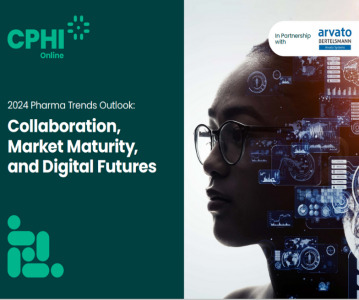Pharma needs ‘mindset change’ to unlock benefits of digitalisation – CPHI Frankfurt preview

For more information about digitalisation in pharma, register to attend CPHI Frankfurt 2022.
Data is increasingly being used to support clinical development, regulatory decision-making and post-approval studies in the pharmaceutical industry. However, pharma’s data landscape remains fragmented, and information is frequently siloed based on business function. In order to reap the benefits of increasing digitalisation, industry must focus on unifying health data and promoting collaboration.
This will be the subject of the panel discussion Data of this World United – What it Takes to Enable Health Data Collaboration Across Organizations and Industries at CPHI Frankfurt this year. To understand the impact of digitalisation – specifically on bioprocessing – CPHI caught up with Mohamed Noor, Digitalisation Manager at the National Institute for Bioprocessing Research and Training (NIBRT). Mohamed will join Sudha Kodati (Accenture), Fabian Gautschi (Accenture) and Tamas Rujan (Genedata) for the panel on November 2 – Register to attend here.

Image: Mohamed Noor, Digitalisation Manager, NIBRT
What can attendees expect to gain from your session Data of this World United – What it Takes to Enable Health Data Collaboration Across Organizations and Industries at CPHI Frankfurt this year?
The unfortunate reality is data in the pharma sector is often segmented into different business functions. There is an increasing drive towards real-world evidence for reimbursement in healthcare. On the other hand, manufacturing colleagues have less visibility into how the drugs that they are interacting with work in the real world. More importantly, there is a need to correlate manufacturing attributes to clinical outcomes.
Coupled with the extensive use of spreadsheets, this disconnect hampers data collaboration and contextualisation. As a typical example, when a critical parameter for a batch exceeds the limits, someone has to manually check the regulatory filing documents to determine the maximum range for a particular parameter. A better way would be to have all the values displayed on a dashboard, so the ranges are available during clinical development and all the way through routine commercial manufacturing.
Another example is when one colleague cleans up a dataset for a particular purpose, but the cleaned dataset is often not made available to their colleagues. Instead, a second analyst might repeat the entire process and end up with duplicated time-consuming efforts. Collaborative analytics can also identify a problem in one manufacturing facility that may also exist in another facility within an organisation’s network. In this session, I will be highlighting how NIBRT is partnering with several leading companies in the space to provide training to enable citizen data analytics and mindset-led transformation, instead of being focused on specific software or tools.
What are the advantages of increasing digitalisation in biopharma?
The biggest advantage of having a digitalised environment is access to data, which in turn, will drive business efficiency. Many companies are still using paper-based solutions and spreadsheets for their operations. These systems are not efficient, especially when considering a complex manufacturing network with in-house and contract manufacturing. It can be thought-provoking to see an organisation trying to compete with other companies when they do not even have visibility into their own processes.
Additionally, technology transfer from one site to another often takes place physically. With the need to reduce carbon footprint and adapting to new ways of working, it will be much more efficient if augmented reality technologies are used to allow experts from the donor site to have a virtual immersive presence in the receiving site without having to fly long distance.
Lastly, the integration of clinical and non-clinical data can drive innovation and help with complex and adaptive clinical trials. Instead of treating these as different sides of a business, data integration can help streamline clinical observations to specific drug chemistry, manufacturing and control (CMC) aspects.
What are some of the challenges companies in the biopharma space may face when increasing digitalisation?
I would say the mindset change has to be addressed first. It is not about adopting any specific technology.
The new mindset requires organizations to move from assuming regulatory aspects as roadblocks to actually working with regulators on technology implementations. In general, conversations between sponsors and regulators should happen more frequently all the way from pre-IND and across clinical and non-clinical aspects. Many exciting new therapies fail to reach their end-goals, and the question is whether the industry as a whole has to look differently at how we work. Digitalisation can help with speed-to-market and fail-early approaches as long as organizations view digitalisation as much more than just having paperless manufacturing or fancy dashboards. There is a need for data analytics, robust clinical trials, immersive technologies and so on.
Secondly, system owners in an organization need to move away from being possessive over systems. It means no one person controlling access to data – great collaborations can only be enabled when employees can ask questions instantly and not wait too long for access to information systems. This is especially important for roles that are cross-department such as manufacturing sciences and R&D. Artificial intelligence is being described as the next step for drug design, but this is just one piece of the puzzle – we also need AI for quality by design in manufacturing and adaptive clinical trials. Everything has to fit together, and not in silos.
Why are you attending CPHI Frankfurt this year?
NIBRT is currently ramping up its training and research activities in digitalisation. Attending this year’s CPHI event will be a great opportunity to understand industry trends, the requirements for talent development in this area and also to get a general overview in the pharma sector.
We have a packed agenda of content and networking opportunities at this year’s event. What are you most looking forward to?
I must say networking. Yes, you can pick up content elsewhere (including Google) but nothing beats the physical interaction with colleagues from other companies! I am also hoping to meet my fellow panellists as we share different ideas to enable digitalisation and collaboration for our client companies.
CPHI’s new brand line is ‘At the heart of Pharma’. What does that mean to you?
Just like many other industries, pharma will continue to see changes in both clinical and manufacturing sciences. It is easy to think that you are the best, but having an external benchmark is better. Pharma-focused events and content that bring together the key players across different organisations will be a good opportunity for sharing knowledge, so CPHI events are definitely ‘at the heart of pharma’.
Related News
-
News On Track at CPHI Milan: Thermo Fisher Scientific Track Sponsor interview
With CPHI Milan just around the corner, we sat down with some of the sponsors for this year’s conference tracks to discuss the most pressing topics in pharma. -
News Viral marketing for B2B pharma businesses: a CPHI Online case study
Discover how a Chinese chemical manufacturing company went viral on TikTok, and what their viral success means for the future of B2B digital marketing for the wider pharmaceutical industry and supply chain. -
News Sanofi to collaborate with OpenAI and Formation Bio
Pharmaceutical giant Sanofi have announced a collaboration with Formation Bio and OpenAI to build AI-powered software for accelerated drug development. -
News CPHI Online Webinar Series – Optimising Pharma Manufacturing through Digital Transformations
This month’s CPHI Webinar Series explored achieving manufacturing excellence in pharma through the digitalisation of daily processes. Presented by Joe Doyle, Head of Sales at EviView, and Bikash Chatterjee, President and Chief Scientific Off... -
News Western pharma groups warn of supply disruptions over China anti-spy law
China’s anti-espionage laws have caused concern among western pharmaceutical groups over potential arrests or denial of access for foreign inspectors in China-based facilities and manufacturing partners, posing a risk to the supply of drug produc... -
News CPHI Online Webinar Series – Innovative Strategies for B2B Pharma Marketeers
On February 20, 2024, CPHI Online hosted a webinar on Innovative Strategies for B2B Pharma Marketeers. Featuring expert speakers from across the pharmaceutical value chain, this webinar delves into how B2B pharma marketeers can create better content to... -
News 2024 Pharma Industry Trends Outlook: Collaboration, Market Maturity, and Digital Futures
The annual CPHI Online 2024 Pharma Trends Outlook, in partnership with Arvato Systems, identifies 12 key industry trends shaping the life sciences industry in the coming year. -
News New Novo Nordisk AI hub for drug discovery to open in London, UK
Danish pharmaceutical giant Novo Nordisk will be opening an AI-based research facility in the heart of London to advance drug discovery operations.
Position your company at the heart of the global Pharma industry with a CPHI Online membership
-
Your products and solutions visible to thousands of visitors within the largest Pharma marketplace
-
Generate high-quality, engaged leads for your business, all year round
-
Promote your business as the industry’s thought-leader by hosting your reports, brochures and videos within your profile
-
Your company’s profile boosted at all participating CPHI events
-
An easy-to-use platform with a detailed dashboard showing your leads and performance



.png)
.png)
.png)
.png)

